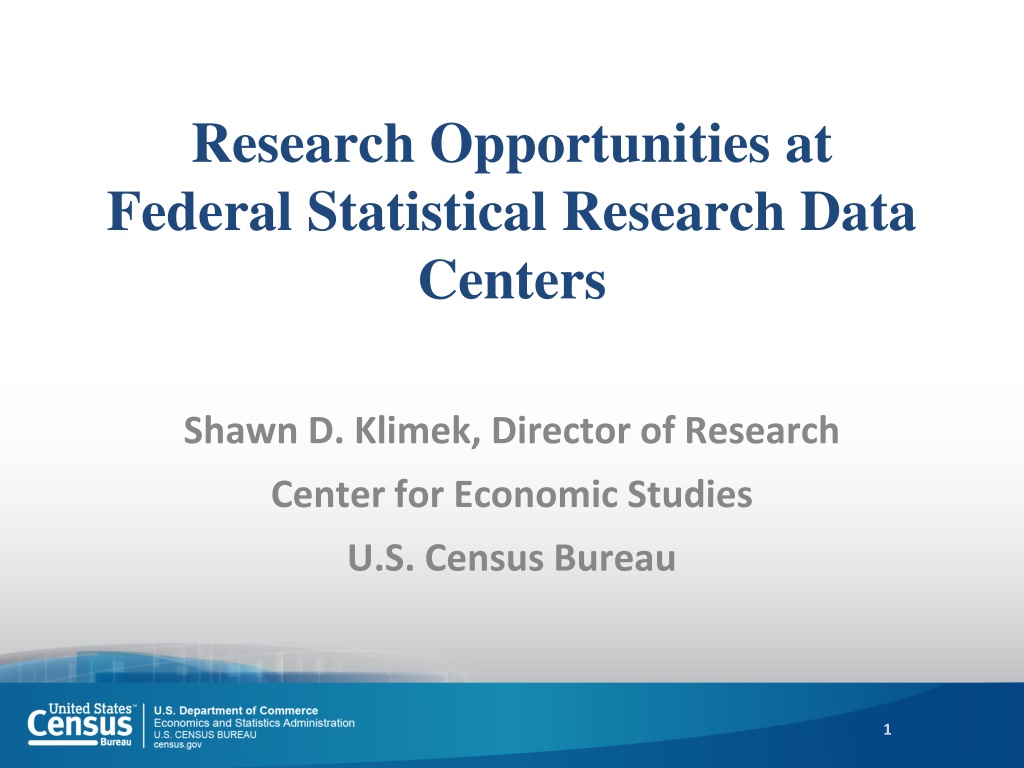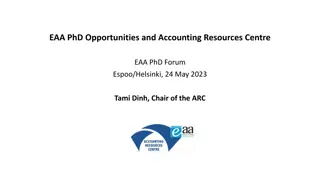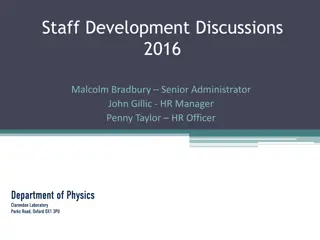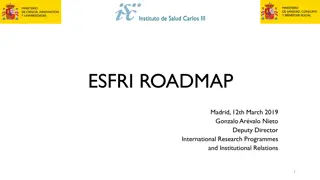
Federal Statistical Research Data Centers Overview
Learn about the Federal Statistical Research Data Centers program, accessing data from the U.S. Census Bureau, National Center for Health Statistics, and Bureau of Labor Statistics. Explore research opportunities and the history of the FSRDC program, including current status and upcoming locations.
Download Presentation

Please find below an Image/Link to download the presentation.
The content on the website is provided AS IS for your information and personal use only. It may not be sold, licensed, or shared on other websites without obtaining consent from the author. If you encounter any issues during the download, it is possible that the publisher has removed the file from their server.
You are allowed to download the files provided on this website for personal or commercial use, subject to the condition that they are used lawfully. All files are the property of their respective owners.
The content on the website is provided AS IS for your information and personal use only. It may not be sold, licensed, or shared on other websites without obtaining consent from the author.
E N D
Presentation Transcript
Research Opportunities at Federal Statistical Research Data Centers Shawn D. Klimek, Director of Research Center for Economic Studies U.S. Census Bureau 1
Goal (and Agenda) Inform potential users and stakeholders about: Federal Statistical Research Data Center (FSRDC) Program Accessing Data U.S. Census Bureau National Center for Health Statistics (NCHS) Bureau of Labor Statistics (BLS) 2
Homework? Prospective researchers in the coming weeks and months should be developing proposals to use the data available in the FSRDCs in support of a grant application to the National Science Foundation in 2016. 3
History of the FSRDC Program Census Bureau wanted to increase access to business data, started at HQ in mid-1980 s Expanded access through remote RDCs in Boston and Carnegie Mellon University in mid-1990 s Partnership with NSF in 1998 Agreements with other agencies (AHRQ and NCHS) in mid-2000 s to use the RDCs Agreement with BLS signed in 2016 4
Current Status of the FSRDCs January 2015: Interagency Council on Statistical Policy (ICSP) approves rebranding of Census RDCs to Federal Statistical RDCs February 2015: new website for the program is launched AHRQ, NCHS, and Census make their data available to approved researchers Currently: there are 24 FSRDCs 2016/2017: 6 additional locations expected to open 5
ICSP Members National Center for Education Statistics* Office of Management and Budget Energy Information Agency* Social Security Administration* National Agricultural Statistics Service Bureau of Transportation Statistics* Statistics of Income* Bureau of Economic Analysis Economic Research Service* U.S. Census Bureau* National Center for Health Statistics* Bureau of Labor Statistics* Bureau of Justice Statistics* National Center for Science and Engineering Statistics* 7
Operations and Oversight Census Lead role in the operations and coordination Legal agreements Points of Contact for partner agencies AHRQ Rachelle Hill NCHS Angela Andrus BLS TBD Governance structure in development Office of Management and Budget and Census leading team 8
Role of FSRDC Program To facilitate research for a statistical purpose. Increase access to a wide variety of micro data Improve utility and quality of federal statistics Address policy questions 9
FSRDC Data Protections Confidentiality Title 13 (Census), Title 15 (NCHS) and Title 26 (IRS) U.S. Code Privacy Act Confidential Information Protection Statistical Efficiency Act (CIPSEA) Census Special Sworn Status (oath for life) Substantial penalties for violation 10
Projects by Agency 7% AHRQ NCHS 53% 40% Census April 2016 11
Administrative Records Clearinghouse (FY2016) Expedites acquisition of Federal and Federally-sponsored administrative data sources, improves data documentation, and maintains privacy protection and secure access to these data sources Confidential Information Protection Statistical Efficiency Act (CIPSEA) Promotes the Federal Statistical System s mission of providing quality, unbiased data to support reasoned, disciplined decisions including enabling higher-quality Federal program evaluations. Supports the Department of Commerce s Data goal and objective 4.2 to Improve data-based services, decision-making, and data sharing within the Department and within other parts of the Federal Government. 12






















